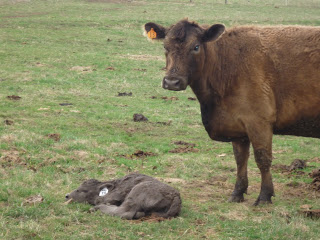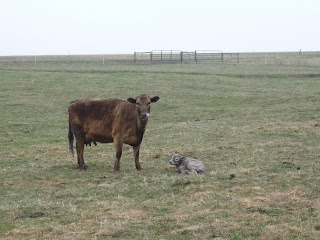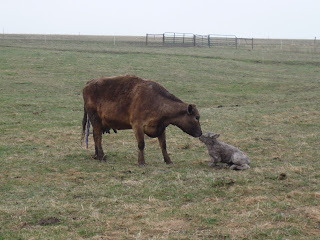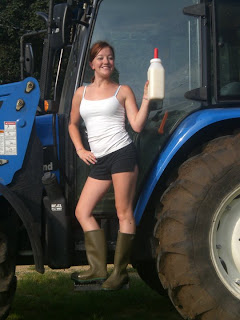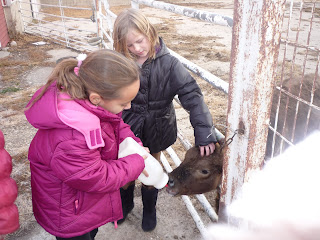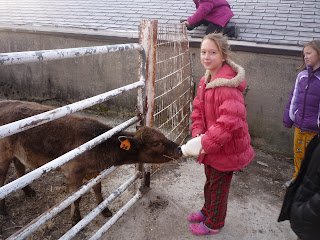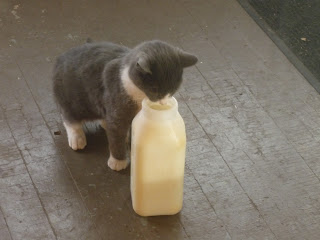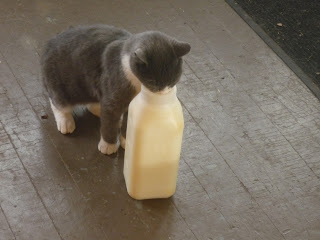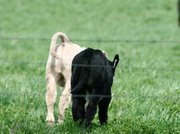
Category: Farm Animals (Page 1 of 4)

Most people don’t tend to think of spring as a date on a calendar. Sure, March 20th is the first official day of the season, but if it’s a blustery, wintry March 20th does that really count? And if it doesn’t, what does?
And what gardener doesn’t joyously exclaim “Spring is here!” when they see the first daffodil, with its bright yellow petticoats, adorning the yard?
But on the farm? On the farm nothing quite says “Spring is here!” like the first calf of the season.
In Irish Grove, Spring officially started on April 8, 2011.
At 9:23 a.m. to be exact.
Remember those days when you were little and your brother or sister got sick?
But slowly you started to get tired of all the attention your sibling was getting.
Grandma came by a second time with jello.
Their friends were calling to see how they were.
And you had seen them playing a little bit….especially when Mom wasn’t looking.
This?
This, my friends…..
is a lot like that.
I hate to make sweeping generalizations here, but farmers don’t traditionally have a lot of money. We’re what you call asset-rich, cash-poor–all of our money is tied up in land, equipment and livestock and pretty much the only way to access that money is to sell the farm. You can get the money but then you’re out of a home and job. (Please remind me once again why I signed up for this?) Of course I use the word ‘we’ here in the most general sense. Marcel and I are even better off: asset-poor, cash-poor. Please dial back your envy.
Anyways, the point of this post is thriftiness. Thrift-i-ness. Farmers have to be thrifty because we don’t have alot of cash on hand. I know most of you are used to the common definition of the word thrifty–showing thrift; economical or frugal, but did you know that thrifty also means thriving or prospering?
That makes sense, doesn’t it? If you’re thrifty you’ll become thrifty and probably stay thrifty, unless of course you start being unthrifty.
Wait, what?
In the spirit of thriftiness, I’d like to now endorse a product that has enhanced my life dramatically in the past few months. It is Pampered Chef’s Quick-Stir Pitcher.
I purchased this pitcher from my lovely cousin who used to be a Pampered Chef saleswoman. I unwittingly attended someone’s Pampered Chef party, enjoyed the company, admired the hostess’ ability to unabashedly sell her wares to friends and family, and then promptly gagged on the free veggie pizza slices as I saw how much everything costs. High quality? Check. High class? Check. High falutin’ tootin’? Check. Affordable for poor ole little ole thrifty me? Nope.
So I did what I always do at these types of events, I frantically flipped pages and searched through the catalog until I found something that met my criteria: 1) useful, 2) not a million dollars. I found it in the Quick-Stir.
To be honest, the Quick-Stir Pitcher pushed my sensibilities a bit. I mean, how hard is it to stir up a chunk of frozen cran-lemon-raspberry-tea with my trusty wooden spoon? Not very! And yet, the next affordable, halfway useful item was the cheese knife, for which a butter knife had always done the trick. The Quick-Stir won out, if only for the fun name. Quick-Stir, Quick-Stir. I could say that all day.
I used it. I did. It came in handy a few times here and there, even though it wasn’t as pretty as my cobalt-blue pitcher I had bought in college. (I have no idea why a college student need a cobalt blue pitcher, but I’ve been glad many times over for that unthrifty purchase.)
Fast forward approximately 9 years and 3 months, give or take a few years, and the darn Quick-Stir is my best friend. Best friend, I tell ya! Ever since Honeysuckle, our bottle calf, was born we’ve had to make up first 4, then 6, and now sometimes 7 or 8 bottles of dry milk replacer per day. I’d start out by adding the dry powder to the bottle itself, slopping it on the sides of the bottle and the porch floor, all the while making a sticky, fly-attracting mess. Then I’d add the warm water and shake, shake, shake, shake, shake. Shake until my back hurt, shake until my brain hurt, shake until I could shake no more. The milk would mix, but inevitably there’d be big chucks of powder floating around in it, stopping up the nipples and frustrating the calf.
And then I remembered the Quick-Stir. I got it out, added the milk powder and warm water, and plunged. Plunged, plunged, plunged, plunged plunged. No mess on the bottles, no mess on the floor, and I’m pretty good at plunging now, just in case the toilet ever gets plugged or some sort of nonsense. I plunged that nifty little plunger up and down until the liquid was a perfectly smooth milky mixture. Remove plunger, pour it into the bottles, and Viola! Breakfast is served.
$16.50. That’s it. That’s the cost of my nifty, thrifty Pampered Chef Quick-Stir Pitcher, the one that makes my porch cleaner, Honeysuckle’s milk smoother, and my life easier. I gotta say, the next time you have a bottle calf on your hands, you just gotta get yourself one of these! Maybe I’ll pitch (ha ha, sorry) a new name to the company while I’m thinking of it–The Pampered Farmer has a ring to it, don’t you think?
Thriftily yours,
Farmer Jackie
If you live in a bubble, you may be unaware that there was a recall of a half billion eggs recently due to salmonella contamination. If you’re not in that bubble, you may wish you were–especially if you’re one of the 1,400+ people sickened by the salmonella in your breakfast burrito or western skillet.
As a small farmer and small-time egg producer, I’ve gotten lots of attention from the egg scandal. I’ve had friends post comments on Facebook telling others to buy safe eggs from Irish Grove Farms. I’ve had comments on this blog asking how I ensure our eggs are free from contamination. And just yesterday I was contacted by our local Channel 13 News team, wanting to come out to the farm and interview me about my supposed increase in customers since the recall. (I was at work, so unable to do the interview. Whew!)
Have I had an increase in customers after the recall? I honestly don’t know. But the reason I don’t know is because I had so many customers before the recall, an empty fridge and disappointed customers is nothing new around here.
The reason my eggs are in high demand, however, is not because they’re salmonella-free (even though they are). It’s because they’re so dang delicious.
A recent news release from Reuters about the FDA inspection at the two contaminated farms stated that, “During inspections conducted on August 19-26, officials found rodent holes and leaking manure at several locations run by Hillandale Farms of Iowa, and non-chicken feathers and live mice and flies at houses owned by Wright County Egg, according to reports posted on the FDA website.”
As a consumer, this sounds gross. I get it: rodents and birds are dirty and carry disease, as do flies. But as a farmer it sounds normal. Can you please take me to a farm that doesn’t have troubles with mice? Or flies? Or barn swallows and bats finding a way in?
Another article made it sound worse, though. At WebMD, it says, “FDA investigators found:
* Huge manure pits open to outside animals.
* Evidence that rodents, wild birds, and other animals could enter the henhouses via missing siding and gaps in doors and walls.
* Actual sightings of rodents, birds, and bird nests inside the facilities.
* So many live flies that they were crushed underfoot on walkways. Maggots “too numerous to count” were seen in at least one manure pit.
* Farm workers went from henhouse to henhouse without cleaning their tools or changing their shoes or clothing — which can spread germs between houses.
* Uncaged birds tracked manure from the pits to the laying houses.
Some of the egg-producing hens were caged above manure pits four to eight feet deep. The weight of these vast manure pits had burst open outside doors.”
OK. So some flies and mice are bad. But manure pits bursting open doors and live flies crunching underfoot is ghastly. *Shudder*
The part that has been overlooked, though , is that the egg-wash water was contaminated with salmonella. According to the Reuters article, “DA officials also said inspectors found salmonella in a water sample collected from a Hillandale Farms plant. The sample came from spent egg-wash water, or water used to wash the exterior of eggs traveling down conveyor belts to the packing facility, said Jeff Farrar, FDA’s associate commissioner for food protection. DeYoung (a spokeswoman from Hillandale–Jackie’s note) said eggs at Hillandale are also rinsed with water containing chlorine as an additional step to kill bacteria.”
This is where the public doesn’t understand what’s going on. You may think that a final chlorine wash will kill the bacteria on the shell and all is well. Except for one major, glaring problem: Egg shells are porous! They have little tiny microscopic holes throughout the entire shell!
If egg shells were air-tight, how could a baby chick could breathe during development? The tiny holes in shells allow air to enter the shell, and if air can get in, so can egg-wash water. Egg-wash water contaminated with salmonella, in this case.
This is something all egg producers know. And it is why small flock owners like myself that sell “Nest Run Eggs”–meaning they aren’t processed (washed, graded, candled) for commercial sale–don’t wash the eggs! The eggs are wiped clean, perhaps, with a damp cloth, any nest bedding materials is flicked off, and the eggs get put in the carton as is. (If I collect a ‘poopy egg’, as I so technically call them, I throw it away if it’s really bad, or I eat if myself if it’s passable, washing it directly before use.)
When a hen lays an egg, it’s wet. The wet layer on the surface of the shell is a protective coating made of protein (called a cuticle) that keeps bacteria from entering the shell. When you wash an egg this coating is lost and bacteria can pass freely into the egg. Washing eggs for a store or for market, which I can do as a licensed Egg Broker, is tricky. You must use the hottest water possible, to make the insides of the egg expand and effectively push back on the water trying to enter. If you use cool water, the opposite will happen and the egg will absorb the dirty water.
So don’t be fooled when a company says they can use dirty wash-water because they give the egg a final chlorine rinse. It’s not the shell you should worry about in this instance, it’s the egg inside–swimming around with salmonella-wash-water. Mm, mm, good.
So what can we do? Well, we can follow the American Egg Board’s recommendations: Cook eggs until the whites and yolks are firm, meaning no more eggs-over-easy or sunny-side-up, no more soft-boiled eggs, no more raw eggs in smoothies….and goodbye eggnog and custards.
And/or you can buy Nest Run Eggs from local producers with healthy birds and wash the eggs directly before use.
And/or you can buy eggs from trusted, preferably small producers that wash their eggs following safety procedures and cleanliness standards.
If you decide to buy eggs from Irish Grove Farms, though, and please do….the problem you encounter may lie more in a lack of eggs than in the quality. Consider yourself fore-warned.
I’ve always loved playing tag. It gives you a reason to sprint, which is an exhilarating feeling. I mean, how many opportunities do you really get to just full-on run as fast as you can?
Except this game of tag is a little different. This time, we’re tagging calves. As in ear-tags. And these calves can not only run super fast, but they can jump, bellow, kick, flip-flop, wiggle, scream, pant, and foam at the mouth like nobody’s business. Which in and of itself isn’t so bad until you add in an angry, over-protective mother who weights 1200 pounds who also knows how to sprint.
We try to tag the calves when they’re little. 5 hours old? Perfect. 2 days old? Not bad. 3 weeks old, like last night’s bullcalf? Not a great idea. At 3 weeks, these suckers are big, strong, fast and super stubborn. They also can make a noise like you’ve never heard before.
Last night presented the perfect opportunity, though, as the mother had walked down to the pasture and left her calf resting peacefully in the barnyard. Ha! The fools! We shut the gate to keep the calf in and the mother out, and the fun started.
Marcel was on lasso, I was armed with the ear tagger. The calf was running wild around the barnyard, but made the mistake of heading into the barn. Ah-ha, gotcha! Marcel caught him around the neck and the fun began. This bullcalf was strong, and started whipping Marcel around the entire barnyard. Marcel was hanging on, trying to get ahold of him to trip him up, but there were hooves flying every which way–and let me tell you, these little calves kick HARD. Finally the calf jumped close to the round bale cage. Marcel took advantage and pushed his body against the cage, wedging him in. I ran up and tagged him as quick as possible: #39. The little bugger.
In the meantime, the kids had entered the barnyard to see if they could help. They could not. But they left the gate open and Honeysuckle escaped into the yard. First off, she was scared to death from all the bellowing and bawling coming from her buddy. And second, she’d never been anywhere outside of the barnyard before, so was immediately disoriented.
Rodeo #2 formed, trying to catch Honeysuckle and get her back in. I yelled at Ana to grab a bottle, the one comfort she knows, while Marcel and Rob were trying to keep her out of the road. We live on a blind hill, the calf was about 6 feet from the road, and we could hear a car speeding in our direction. (A good reason to SLOW DOWN on rural roads, people!) Honey kept running erratically towards the road, then back again. Luckily she froze when the car got close–it was a full-sized van.
How traumatic would that have been? Shudder.
Marcel finally lassoed her, so was able to keep her from the road, and by then I had the bottle in hand and led her back to the barnyard. Whew! What an evening!
One more to go, though. We had to drive down to the pasture to find this one–a heifer calf, about 10 days old. She’s still pretty sleepy, though, so tagging her wasn’t the issue. Keeping the mother away was. After Marcel lassoed her around the neck, we slowly chased the mother and babe around until they were close to the fence. I drove the PUG inbetween the mom and babe, at which point Marcel grabbed her and tried to tag her.
Only problem? The tag didn’t clasp correctly. So now he’s trying to get it to clamp down and secure itself while the mother is chasing him around the PUG. I’m warding her off with a stick, but don’t want to use it forcefully unless she’s really going to attack him because we rely on trust to move these cows from paddock to paddock. Thankfully she’s calm enough to not attack, and only wants to know that her babe is OK. Job done, Marcel tired, excitement had.
We really need a sophisticated corral for these jobs. Any anonymous donors out there?
Anyone? Yoohoo! Hello!? Tap-tap-tap. Anyone?
Damn.
We are in the middle of a typical August heat-wave. You know the kind. The kind that turns the winter-haters into winter-aficionados. The kind that creates a perpetual background humming noise, which is the din of a gazillion air-conditioners straining to keep things cool. The kind that gives you that lovely summer glow, a.k.a. sweat-shine. The kind that has you sleeping in your skivies because it’s so bleepin’ hot in here!
I’m weathering the heat just fine. You see, I’ve got that typical Irish Catholic point of view that a little suffering is good for the soul. Marcel’s holding his own–his Panamanian alter-ego might tell you to suck it up, because this ain’t nothing compared to back home in Panama. The real Marcel, of course, would never say that. And the kids are a little more lethargic than usual, but surprisingly uncomplaining. (We don’t have air-conditioning. Air-conditioning is for wimps.)
But the cows? The cows aren’t happy. And who, really, would blame them? They’re stuck in the middle of a field with lots of good food and fresh water, but also lots of flies and the blazing sun beating down on them all day.
They’ve responded to the heat with a little revolt. Perhaps you would call it a small protest. It’s just a small one, but it’s there all the same. They’ve started purposely tipping over the moveable water tank. That’s right, they tip it over and slosh around in the ensuing mud like a bunch of pigs. Pigs, I tell you! Since when did a cow aspire to pig-like status?
It’s actually quite a problem, though. Because while the huge wave and ensuing splash of cool water and mucking up of my lovely pasture assuredly feels great at the moment, about 15 minutes later they get a little thirsty. Sure, there’s a trickle of water continuously flowing out, putting a lovely strain on the water pump, have you. But when you’ve got 40+ hot and thirsty cows, a trickle ain’t gonna cut it.
No lecturing by me is gonna make them any happier, nor will it stop the water-tippin’. So, I’m wondering if this isn’t just a bad idea. You know, keeping them on our grazing plan, out in the sun in this terribly-hot weather.
The strict (successful) graziers might say something like, “grazing-cattle must be tough and able to withstand the extremes. You gotta push them to the limit and select for hardiness. How are you going to know which cows are suited to grazing if you provide them with pillows and soft blankets at the first weather-test?”
The traditional cattlemen, the grain feeders, might say something like, “This proves that rotational grazing doesn’t work, that it’s bad for the cows, and that the confinement and/or grain-based feeding system is ubiquitous because it’s the only one that works.”
(True graziers and grain-feeders might say this, or they might not. They are a varied lot.)
The mother in me would bring them in to the tree-lined pasture for a few days, to give them a little relief from the hot sun. Which means they would really just stand in the round barn all day, pee and poop constantly until the barn floor is covered in a green soupy mess perfect for breeding more flies, skin infections, and diarrhea in the calves.
The farmer in me, though, is inclined to leave them in the pasture and just check on the water more often. Why? Not because I’m a big meanie, although you can accuse me of it if you’d like. But because for one, I don’t want skin infections, flies and diarrhea. And two, if we brought the cows in for every weather-event, be it large storms, heavy rainfall, extreme heat, stiff winds, extreme cold, etc….they’d never be in the pasture!
I’m open to suggestions, though. Let’s hear what ya got.
Our downed mother cow is still down. It has now been 2 weeks and we’ve lost hope that she’ll get up. It’s heart-wrenching to see her. She’s getting sores on her legs, and her front legs have lost their muscle tone as well.
We’ve gotten her up using the hip lifters a few times, to no avail. When we lower her to the point where she has to support her own weight, the legs just melt underneath her. They are useless.
The sad truth is we are going to have to put her down. It is a painful decision to make, but we don’t want her to suffer any longer. We’ve kept her as comfortable as possible, with a shade tent over her, fresh grass and water every 2 hours (many thanks to Mom and Gordy for taking over this job for the past week), fly spray to keep the darn things off of her, and some green apples for treats. But she is fading and it is obvious she is giving up hope as well–her ears are drooping and she’s no longer making an effort to stand. We are going to have to help her along in her journey so she doesn’t suffer any longer.
Honeysuckle, her calf, has given us a few scares as well. For the first week, she would hardly wake up to eat. When we’d call her, her eyes would open and she’d start to lick her lips but she wouldn’t raise up her head. It’s quite alarming when you grab her by the ears, lift her head up, and then let go only to have her head flop backwards in an awkward position. There were many times where we had to check her breathing to make sure she was still alive. When she’d finally wake, she would eat only a little bit before lying down again.
The past two days, however, have been a different story. All of a sudden she’s perked up. Marcel gave her a strong dose of vitamins in the form of a paste and I read online that perhaps I was making her milk too strong. I’ve diluted her milk-replacer a bit and she’s chugging down 2 bottles, twice a day and still asking for more. What a relief!
She really is adorable. Madelina and Armando have taken it upon themselves to be her playmates–riding their bikes around in the barnyard with her, jumping around and teaching her how to kick up her heals. It’s pretty hilarious. And she is now my personal alarm clock, mooing loudly at the gate first thing in the morning, awaiting her breakfast. She gets going at around 5:30 a.m., not caring that I don’t like to get up that early. Marcel just laughs and says, “Your newest daughter is calling you.”
I’d rather he said, “Don’t worry, sweetie. I’ll feed her.”
Oh well. She’s doing well and is the one positive outcome from this situation, so I’m not going to complain. OK, so maybe I’ll complain a little.
I wish I had happier news to share with you about the mother. If there’s one lesson that farmers learn early and often: there isn’t always a happy ending.
